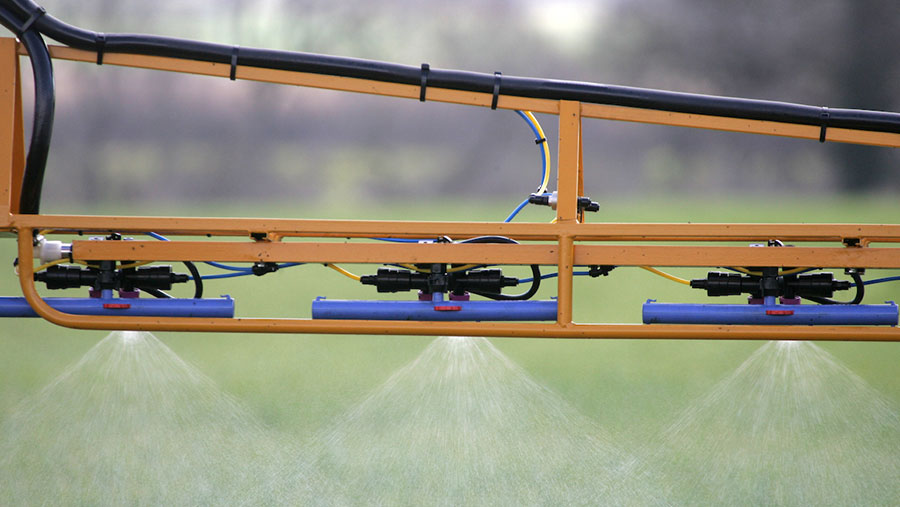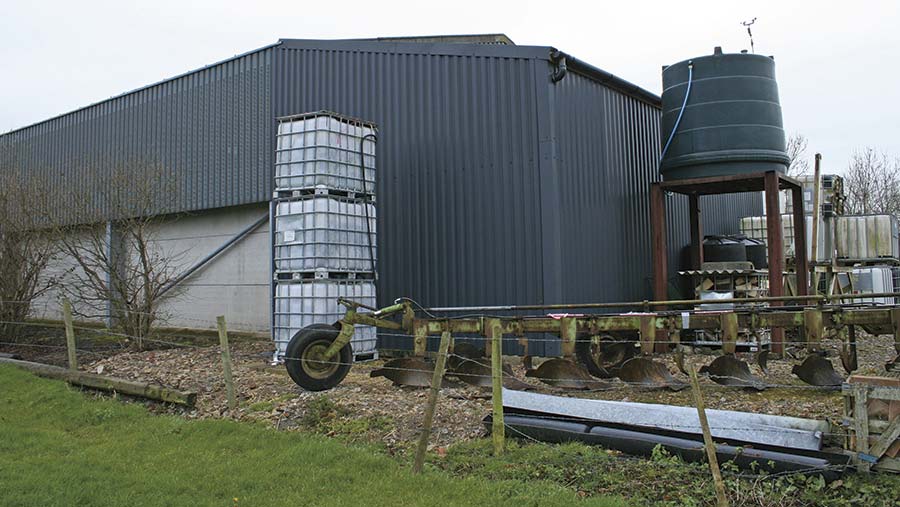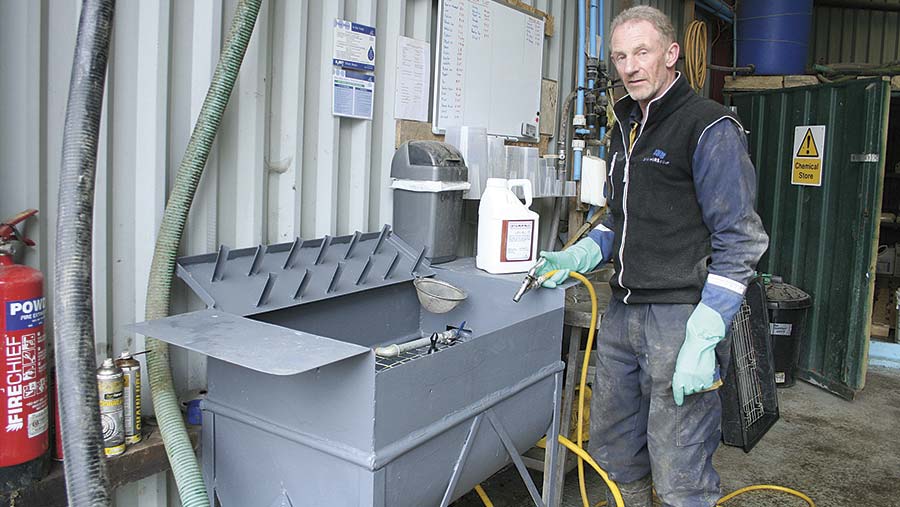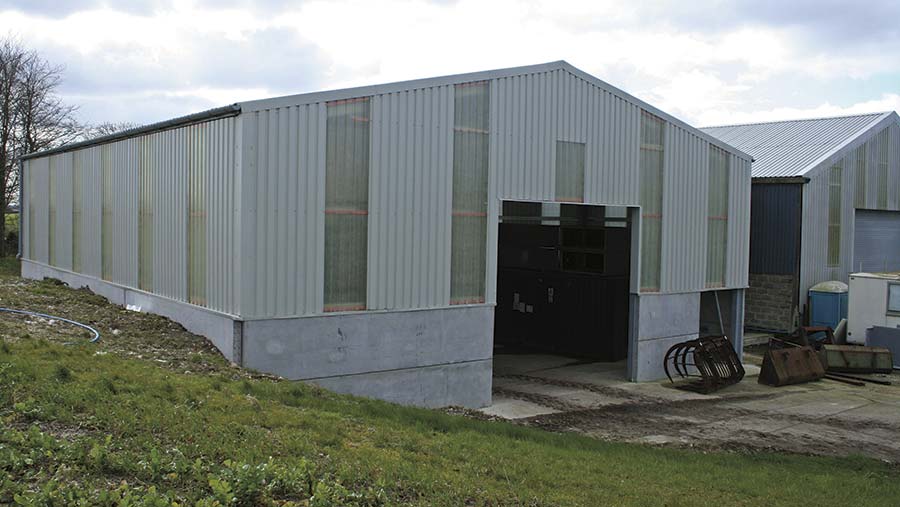Two farmers give their tips for building the perfect sprayer filling area
 © Tim Scrivener
© Tim Scrivener A covered area for storing, filling and servicing the farm sprayer can be as grand or as simple as you like.
Either way, it’s a facility that can provide more pleasant and convenient working conditions, as well as a means of clamping down on pollution risk.
Filling a sprayer in the yard on permeable material is no longer acceptable because of the water contamination risk of even the smallest spillage.
That can be as seemingly innocuous as the droplets on a single dropped and overlooked foil from a pesticides container, which has the potential to pollute a stream for as much as 30km.
See also: Top tips to help you switch to controlled-traffic farming
A concrete pad is the solution – as long as its edges are raised sufficiently to prevent spilled chemical and sprayer wash-down water from simply flowing off the edge.
It should also have drainage to a collection point for treatment and/or disposal.
Having a concrete filling pad such as this under cover has the obvious benefit of excluding rainfall and therefore the quantities of liquid involved, which is a particular advantage if biofiltration is used as a clean-up process.
But if it also provides a storage location for the sprayer, the pollution risk from drips or rain washing off residues is eliminated.
Marden House Farm, Wiltshire

© Peter Hill
The steelwork from a workshop lean-up taken down to make space for a bigger machine fettling facility was the inspiration for the covered sprayer filling area at Marden House Farm in the village of Marden, near Devizes, in Wiltshire.
It provides secure storage for chemicals and the 3,000-litre front and rear tank sprayer used on the 450ha mostly arable farm, and a place where the sprayer can be power washed with all run-off safely contained.

© Peter Hill
The lean-to is attached to a building recently converted from a cattle shed to a crop store, so concrete grain walling lines one side, while the other side and the end wall are formed from new full-length steel profile sheet.
Inside, the concrete floor has a raised edge around its perimeter and also around the steel chemical store sited in one corner to contain any liquid.
With a bung shoved into the open drainage channel that runs from front to back, this bunded area will keep more than 2,000-litres contained within the building.
Under normal circumstances, the channel carries sprayer wash-down water and container rinsing water to a filtration system.
Contaminated water passes through a settlement sump before passing into a second sump, from where it is pumped to the top of the three-stack biofilter.
This was assembled according to Catchment Sensitive Farming guidelines, which require the use of new, not used, intermediate bulk containers (IBCs) filled with a mixture of straw, soil and compost.
Once the contaminated water has dribbled its way through the stack, it is clean enough from a pollutant aspect to be used again.
But because it emerges dirty, Andrew Woolley prefers not to put it back through the sprayer but rather to add it to the waste water system of the farm’s beef unit.
A good, fresh water supply is another key requirement, so a 5,000-litre tank outside the building fills the sprayer’s tanks in a few minutes and is itself replenished by an upgraded 32mm mains supply to ensure sufficient water for the final loads on a long spraying day.
Chemicals for the rear tank are emptied into the built-in induction hopper, but for the front tank are transferred via a dairy wash tank converted into a container rinsing unit.
Supplied by a 200-litre water barrel located on top of the chemical store, the wash tank is equipped with a pair of container rinsing jets – one spinning, one blade-type for shifting stubborn deposits; a sieve to hold the seals before they are rinsed and deposited in a small flip top waste bin; and a draining rack for pesticide containers.
Deverel Farm, Dorset

© Peter Hill
Few farms have a purpose-built facility dedicated to spraying operations but the 324ha all arable operation at Deverel Farm in Milbourne St Andrew, Dorset, can lay claim to one of the finest.
The newly-built structure based on a galvanised steel frame provides a spacious, light and airy facility.
The farm’s location in a high-risk water catchment area and grower John Martin’s inclination to do things as best as he can, led to the project, which has been completed as profits and other investment needs have allowed, on top of a £10,000 grant from the government’s Catchment Sensitive Farming initiative.

© Peter Hill
Mr Martin’s building encloses a 13mx16m concrete pad that shelves to a central drain and a 3,000-litre tank beneath.
Together with the concrete bund around the pad, the facility provides a more than adequate capacity of 21,000-litres – more than enough should the 4,000-litre trailed sprayer accidentally disgorge an entire fill.
There are two large doorways positioned for drive-in, drive-out operation that will be filled by roller shutters in due course, and the two layers of concrete panels that form the lower section of the walls are topped by two layers of steel profile sheet with Rockwell insulation between them.
Secure chemical storage is provided by a purpose-built container, and chemicals are moved on a hand cart to make them available at waist height alongside the sprayer when filling, using the built-in induction system.
A home-made wheeled draining rack takes care of the pesticides containers once they have been emptied and rinsed, and an engine-driven power washer provides a quicker and more thorough wash-down than would be the case out in the field using the sprayer’s on-board hose.
Washings disappear into the buried storage tank from where the liquid is pumped to a six-stage biofilter stack positioned inside the building.
The 1,000-litre IBCs are filled with soil, compost and straw, and tests have shown that the scrubbed water is clean enough to go down the drain – but instead it is applied on to adjacent land.
It was more by accident than design that Mr Martin realised he could open a section of the sprayer’s boom inside the building.
But it’s a welcome feature, he says, because the sprayer can be filled without standing under a folded boom and there is clear access for servicing and maintenance in the comfort of an enclosed space.

